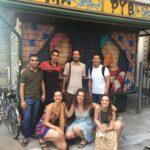The University of Pisa as place of real integration: toward the construction of a support network for international students
A place is never just that place: rather that place becomes infused with a part of us. Somehow, even unbeknownst to us, we carry it around with us until one day, by chance, we get there.
— Antonio Tabucchi, “Viaggi e altri viaggi”
The University of Pisa is a reference point in the academic world, a cornerstone institution in the city which has always enlivened the city itself; as a place of culture, the University recognizes its social role, in fact the Athenaeum’s purpose is to “elaborate, develop, transmit all knowledge and contribute to the progress of society […]. It marks its action on the democratic method, ensuring the widest participation […].It promotes actions that encourage the overcoming of all types of discrimination […]. It promotes the conditions that make the right to study effective.” (Social Report of the University of Pisa, edited by A. Carlesi, Pisa university press, 2013, pp. 7 e 8).
As students of Pisa University, we have taken up the challenge of equality that our university proposes us daily and we’re glad to be part of the Mentorship Project, which allow us to realize values such as solidarity and integration, for an increasingly inclusive university.
Unfortunately, in this context of restrictions to sociality and remote teaching, university is more and more a non-place and, consequently, the sense of community is dimming too; therefore, it is necessary to build an inter-disciplinary support network and that’s what the newly founded group of Mentors has laid the foundations for. But it’s not enough: we’ve started working on sociality too, organizing a walk with three students who contacted us.
This city walk’s been the first meeting between us mentors (and with the guys) beyond the screen and on the streets. The atmosphere was full of curiosity and desire to involve, so we took our new friends to the city key places, telling the story behind the stones that make up the squares so familiar to us, to make them familiar to their eyes too. With the sun on the building façades and a smile on our faces, we continued walking and talking, giving them something but receiving much in return: they told us about their customs and traditions, they explained us the meaning of their names… we greeted warmly with the commitment to see each other more often.
The spirit of our meeting made me understand why I care so much about the Mentorship Project: it’s an active and direct commitment to inclusion and integration (in a peer-to-peer perspective), so that together we can overcome geographic, linguistic, cultural barriers and all the other difficulties with being a migrant student.

